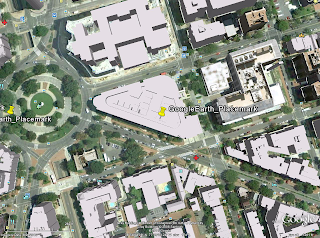Department of Architectural Engineering
104 Engineering Unit A
The Pennsylvania State University
University Park, PA 16802
Contacts: Amy MacIntyre, PHONE (814) 863-0075, E-MAIL amacintyre@psu.edu
Joel Solkoff, PHONE (814) 272-0130, Cell (215) 518-7847, E-MAIL jes535@psu.edu
FOR IMMEDIATE RELEASE
September 21, 2011
Special 3-D Construction Session to Reduce Health Care Costs and Improve Quality
University Park, PA - On Thursday, September 22, at 9:30 a.m. Penn State’s Department of Architectural Engineering will be hosting a session entitled “Using Virtual Reality to Construct/Remodel Health Care Facilities & Independent Housing” in the Alumni Suite at the Nittany Lion Inn.
The session is part of the Pennsylvania Association of Rehabilitation Facilities’ (PARF) annual conference which defines the agenda for the Commonwealth’s disability community. PARF is a statewide organization of facilities serving individuals with physical, mental, social and/or emotional disabilities. This year, for the first time since PARF was established in 1969, the organization has reached out to Penn State’s Architectural Engineering Department for its expertise in virtual technology. Gene Bianco, PARF’s CEO and President explains, “I was impressed by the ability of 3-D and 4-D technology to help our membership cut costs while increasing quality.” [3-D provides images that appear life-life in three dimensions; 4-D adds time as a dimension, and so, when building a home for the elderly, provides the viewer with the ability to see the construction of the building during intervals, for example, of 3, 6, and 12 months.]
Panelists
Panelists for the virtual reality session include architectural engineering professors Richard Behr and John Messner. Behr, as director of the Smart Spaces Center for adaptive aging in the community, has been called one of the country’s early prophets of the concept of “aging in place” as a way of preserving individual dignity and saving the considerable costs involved in institutionalization in assistive living facilities.
Messner, who as director of the Computer Integrated Construction (CIC) Research Program, has been using virtual reality to involve end users in the design to create hospitals, health care facilities, and housing for the elderly and disabled.
Panelist Sonali Kumar, a graduate research assistant to Messner, will be demonstrating two aspects of virtual reality directly related to the members of the audience who have signed up for this session. The first aspect is the work she has done in creating an animated 3-D model of a residence designed for an elderly family whose members may have a disability or may develop one over the course of the aging process.
The second aspect Kumar will be demonstrating is experience-based design, a generic description of a body of academic literature that focuses on the importance of consulting with users in the design process. There are a number of users and end users affected by the way health care and facilities for the aging are designed. They include, for example, residents of the facility, health care providers, maintenance personnel, and people involved with the construction. Kumar’s final model will reflect observations from elderly residents of Addison Court, a State College residence for the elderly, planned critiques from a member of the deaf community, and comments from the mobility disabled community. Kumar changed the model to reflect changes from a wheel chair-based observer who suggested replacing an additional bathtub with a roll-in shower.
The fifth and final panelist Joseph Fagnani provides the prospective of a likely resident of an independent living facility for the aged. Fagnani is an Altoona, Pa based visual disabilities advocate who has been legally blind since childhood. Fagnani has the understanding and skill to provide design suggestions to a model intended to visualize how construction takes place even though he is blind. One of Fagnani suggestions is that controls for the stove use voice synthesis to inform residents when burners are turned on and whether the heat is low, medium, or high.
Audience participation
The following profiles are a sample of organizations represented by audience members who have signed up for the session:
Transitional Services, based in the Pittsburgh area, provides up to 240 units of permanent housing in addition to temporary housing and services for individuals with mental disabilities leaving state mental facilities. The organization has $7.5 million in operating expenses and serves 390 individuals. http://www.transitionalservices.org/index.php
Clearfield-Jefferson Mental Health/Mental Retardation Program. With an annual budget of $4 million from federal and state sources, this organization provides a wide range of mental health services including housing. Participant Susan Hartzfeld, Intellectual and Developmental Disabilities (IDD) Director points out that her organization’s name will soon change to reflect legal and other requirements that the “r word is an inappropriate and insensitive designation.” http://www.cljmhmr.com/
JEVS Human Services, based in the Philadelphia area, serves more than 20,000 individuals each year. According to participant and JEVS Director Jill Rogers, the organization plans new housing construction for the up to 25 elderly and disabled residents and is looking forward to learning how virtual reality “can be a useful tool.” http://www.jevshumanservices.org/
Spectrum Community Services, based in Berks and Carbon counties, was originally founded in 1979 by a group of parents who were looking for living arrangements for their grown children with intellectual and developmental disabilities. In addition to a variety of housing options, SCS also provides support services. http://www.spectrumcommunityservices.org/
Allied Services, serving the Scranton/Wilkes-Barre area, provides rehabilitation medicine, senior care, home health care, and vocational and residential services. The organization, which serves nearly 5,000 people a day, is the largest employer in northeastern Pennsylvania. http://www.allied-services.org/
# # #







